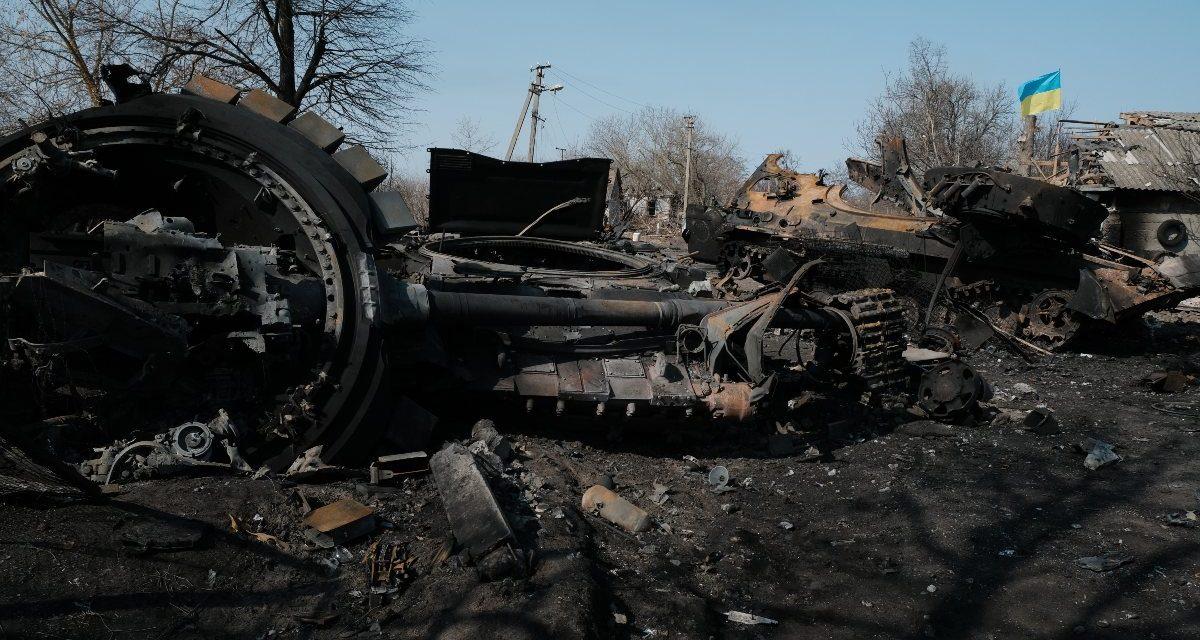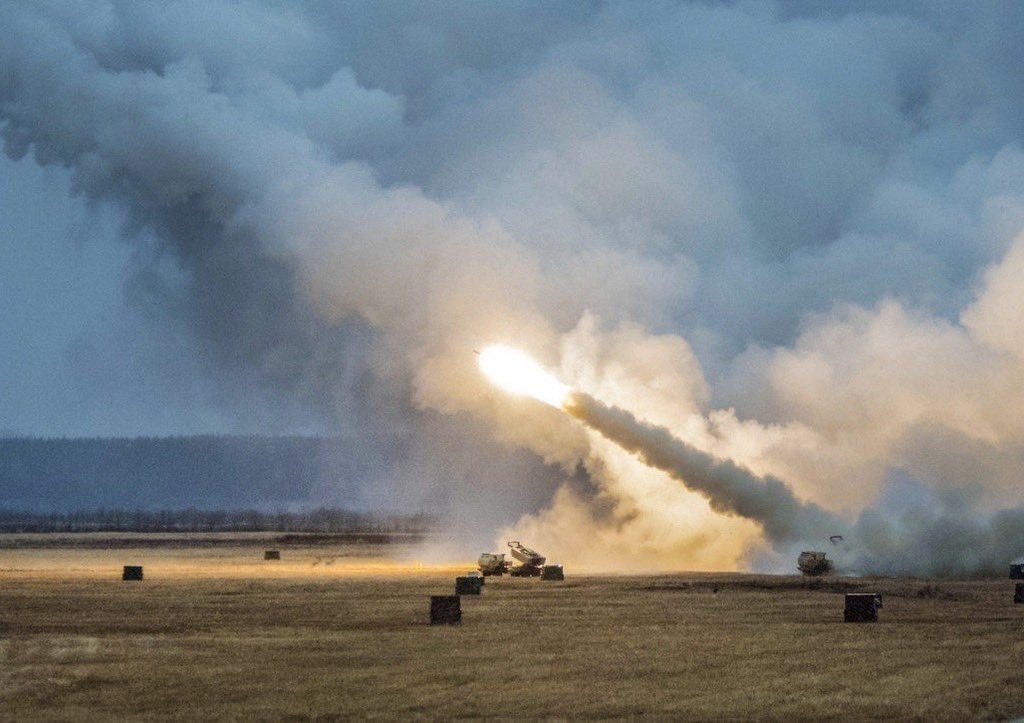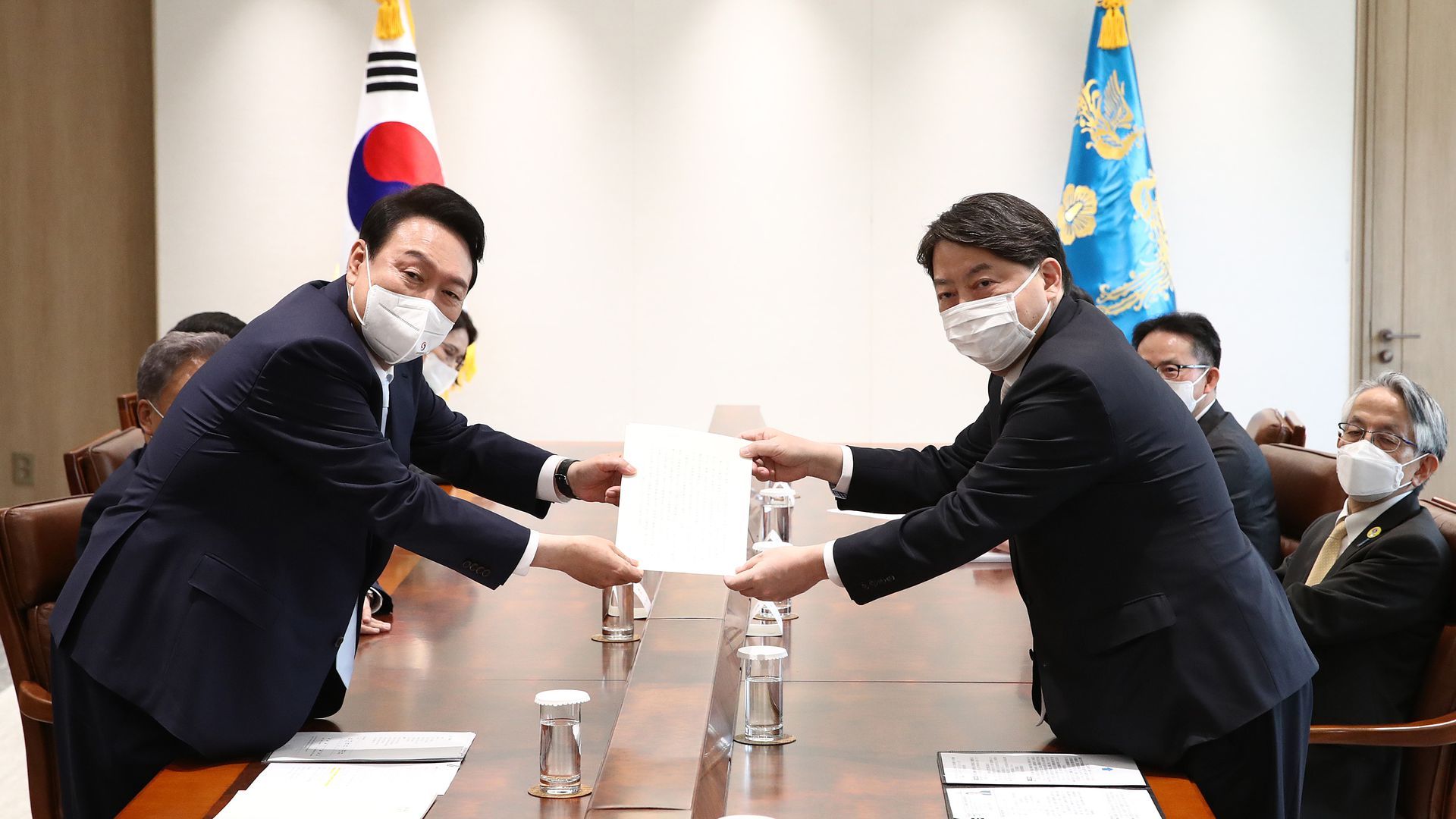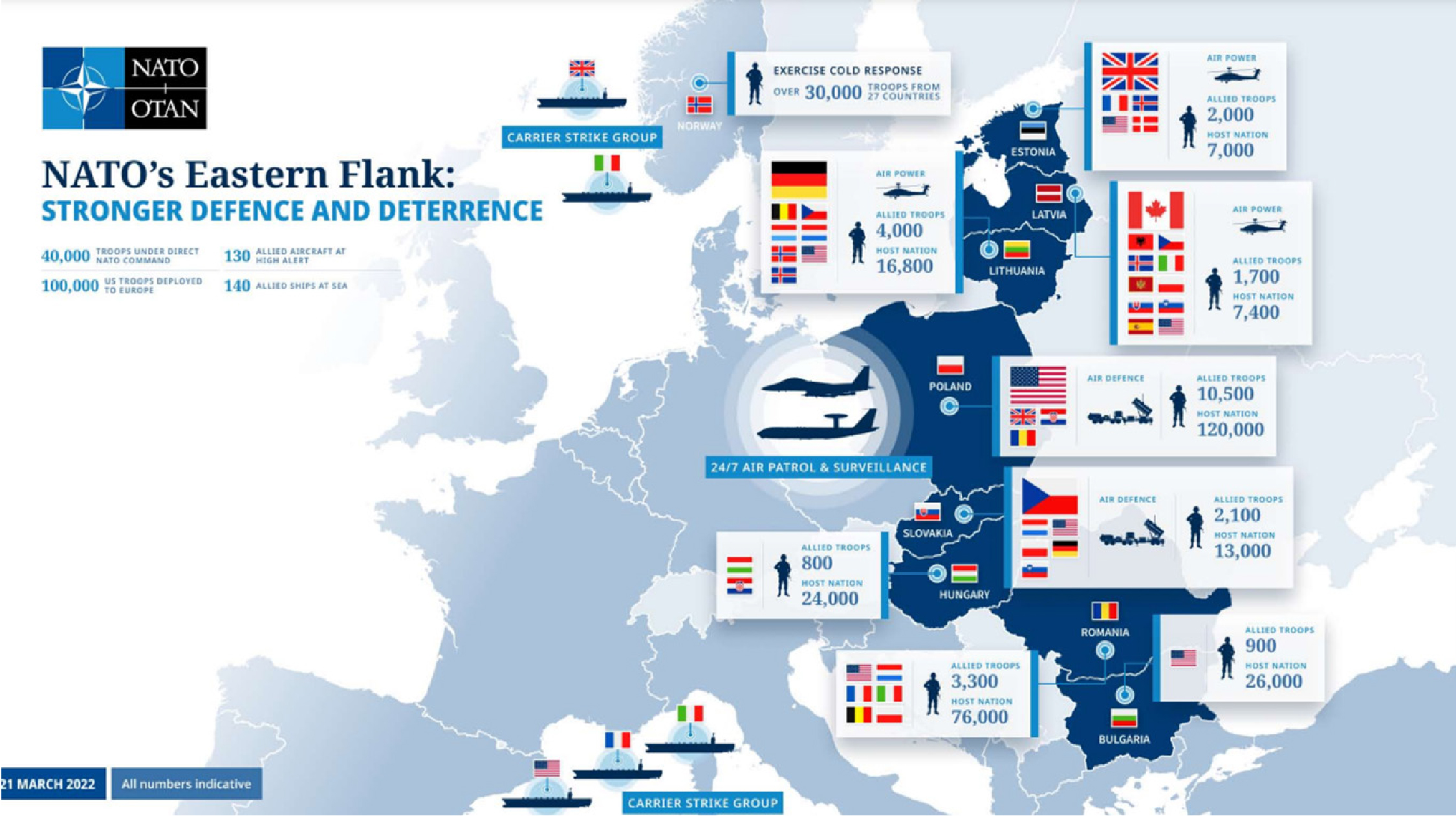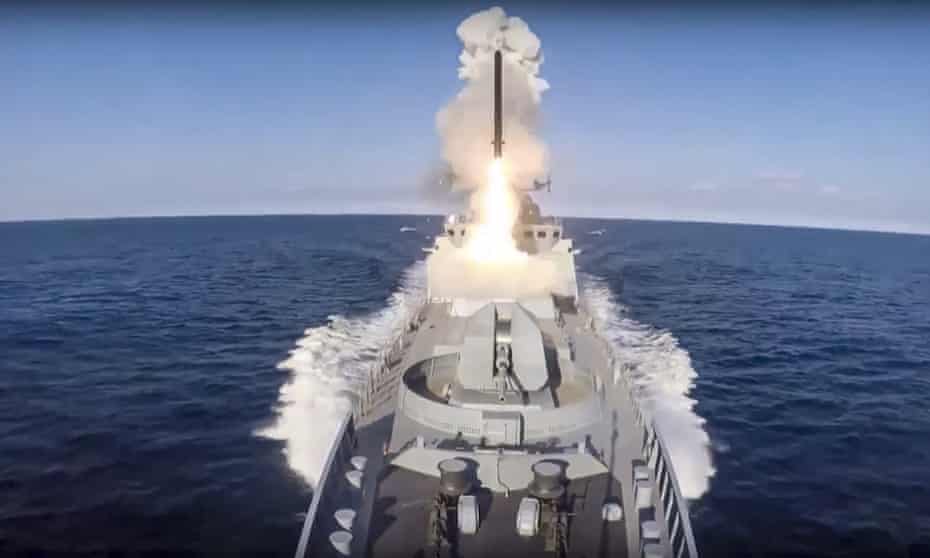Introduction
The North Atlantic Treaty Organization’s (NATO) leaders gather in Madrid this month to unveil the eighth strategic concept the alliance has adopted since the Washington Treaty was signed in 1949. The Madrid summit comes at a crucial moment in NATO’s history. In response to Russia’s full-scale invasion of Ukraine and stated intent to overturn the existing security order in Europe, the alliance has committed to “resetting” its long-term approach.2 In preparing to endorse their latest vision, its leaders may wish to return to the alliance’s first concept for inspiration. That document set out a series of “defense principles” that endure to this day. One, in particular, stands out:
A basic principle of North Atlantic Treaty planning should be that each nation should undertake the task, or tasks, for which it is best suited. Certain nations, because of the geographic location or because of their capabilities, will appropriate specific missions.3
This principle can be seen today throughout NATO’s response to Russia’s invasion of Ukraine. It has deployed elements of the NATO Response Force (NRF), bolstered existing Enhanced Forward Presence (EFP) missions, and added four new multinational battlegroups, transforming its presence across Eastern Europe.4 The nations that host and contribute to these missions do so “because of the geographic location or because of their capabilities”—whether British armor in Estonia, U.S. missile defense in Poland, or French air defense and armored vehicles in Romania.5
Figure 1: NATO’s Eastern Flank
NATO’s reassurance and deterrence efforts in the wake of Russia’s invasion is the Joint Expeditionary Force (JEF). The JEF is a group of 10 nations including Denmark, Estonia, Finland, Iceland, Latvia, Lithuania, the Netherlands, Norway, and Sweden and led by the United Kingdom.6 Due to their common geographical identity, the JEF is focused on security and defense in Northern Europe.7 In the wake of Russia’s invasion, the JEF has coordinated military activity, held a leaders summit in London attended virtually by President Volodymyr Zelensky, and deployed forces and a military headquarters to the Baltic region for the first time.8 The JEF is an example of NATO’s Framework Nations Concept (FNC), established at the Wales Summit in 2014 to encourage multinational groups within the alliance to develop deployable capabilities, led by a “framework nation.”

Whether through the NRF, EFP, multinational battlegroups, or FNCs such as the JEF, NATO’s response to the new European security environment shows the benefits of pursuing a model where nations undertake the tasks to which they are “best suited.” This paper explores whether NATO should do more beyond Madrid to harness the benefits of one of its founding principles through improving the FNC. It does so in three parts. First, it recaps the genesis of FNCs and their basis in NATO’s history. Second, it analyses the UK-led JEF model in more detail to draw out lessons and insights for developing the FNC. Finally, it looks beyond the JEF to consider the development of other FNCs—both existing and new (regional and thematic).
NATO’s Framework Nations Concept: Back to Basics
At the Wales summit in 2014, NATO’s leaders endorsed the FNC, which encouraged groups of nations within NATO to come together to “work multinationally for the joint development of forces and capabilities required by the Alliance, facilitated by a framework nation.”9 Three framework nation groups were established, led by the United Kingdom, Germany, and Italy.10
The aim of “framework nations” was to address persistent political and military shortfalls among NATO’s European members. Some of these had been revealed when they struggled to conduct air operations without significant assistance from the United States over Libya in 2011 under Operation Unified Protector11 It was also designed to capitalize on the hard-fought experience allies gained operating together under NATO’s International Security Assistance Force framework in Afghanistan. At the time, Anders Fogh-Rasmussen, then NATO secretary general, argued for European NATO nations to increase their “deployable and sustainable capabilities, as well as mustering the political resolve to use them.”12
REGIONAL SPECIALIZATION
The thinking behind framework nations harked back to the basic defense principle of regional specialization outlined in NATO’s first strategic concept.13 When the first strategic concept was endorsed in 1949, this principle was immediately put into action. NATO’s military authorities stood up five Regional Planning Groups (RPGs) to produce local contingency plans for defense against Soviet aggression.14
The five original RPGs were: Western Europe, Northern Europe, Southern Europe and the Mediterranean, the North Atlantic Ocean, and Canada-United States. The European RPGs were phased out from 1951, when NATO introduced a new integrated command structure and stood up Allied Command Europe.15 The Canada-U.S. RPG remained, while the North Atlantic RPG became Allied Command Atlantic.16 The importance of the regionalized approach was made clear in a 1951 planning memorandum that phased out the RPGs: “The Northern Region has been specifically asked to make plans for operations in the Baltic . . . an essential factor of the sea/land complex of Northern Europe.”17 These plans would be delegated to the commander-in-chief of Allied Forces Northern Europe, who would take over regional planning. The origins of the FNC can therefore be traced back to NATO’s original RPGs, with the JEF being rooted in the Northern Europe RPG.18
MUTUAL COORDINATION
NATO’s first strategic concept also set out another basic principle of defense planning that the framework nations concept seeks to exploit:
The armed forces of those nations so located as to permit mutual support in the event of aggression should be developed on a coordinated basis in order that they can operate most economically and efficiently in accordance with a common strategic plan.19
The purpose of mutual coordination was to achieve “maximum efficiency of their armed forces, with the minimum necessary expenditures.”20 At the time of NATO’s founding, this was a major concern for the allies for two reasons: economic recovery from the war and the strength of Soviet forces.21 These two concerns dominated again prior to NATO’s Wales summit in 2014, when the FNC was conceived and endorsed due to ongoing policies of austerity among allies and Russia’s seizure of Ukrainian territory by force.22
The measures taken in Wales were designed to respond “to the challenges posed by Russia and their strategic implications” by exploiting the efficiencies of mutual coordination.23 While the 2012 “Smart Defense” was designed to encourage efficiency through joint equipment procurement and capability development, the FNC took this idea further.24 It adopted a wider view that nations with “regional ties” and long-established traditions of working together could coordinate their training, exercising, interoperability, doctrine, and operational formations.25
Mutual coordination through regional ties enables nations that prefer to work together to formalize and develop those relations under NATO’s umbrella. For example, the idea of the JEF allies being “like-minded” was central to its appeal, with the JEF even described by one defense minister as a “Force of Friends.”26
Framework nations also recognized that not all nations were equal: not every ally was able and willing to take leadership roles. Larger nations capable of doing so could gain practical and reputational benefits by leading coalitions, while smaller nations could benefit from being part of regional formations.27 As one analyst suggests, FNC “represents probably the most evolved form to date of matching the capabilities and contributions of larger and smaller European Allies.”28 This did not mean smaller allies contributed less; instead, they did so proportionately to their means, in the spirit of NATO’s basic principles.29
It is true that “applications of framework nation arrangements among the Allies are almost as old as NATO itself.”30 The development of the JEF and its utility, particularly in recent months, shows the benefits of this approach in practice in NATO’s contemporary environment.
The Joint Expeditionary Force: Putting the Framework Nations Concept into Practice
The JEF is perhaps the leading example of the FNC in practice. The war in Ukraine has seen the JEF evolve beyond the aims set by NATO leaders in Wales to become a political-military entity in its own right. The JEF’s development since 2014 may therefore provide inspiration for the future of framework nations in NATO beyond Madrid and the next strategic concept.
The United Kingdom’s intent to form the JEF was originally declared in a 2012 speech by then chief of the defense staff, General Sir David Richards: “The JEF will be of variable size; a framework into which others fit.”31 It was conceived and “designed to meet our NATO obligations,” based on the experience of Libya, where “Jordan, Qatar and the United Arab Emirates were able to play a vital role by bringing their regional expertise into the command structure of a NATO operation.”32
The JEF established its own political momentum through a letter of intent signed on the same day as the Wales summit by the original seven members, followed by a formal memorandum of understanding (MOU) in 2015.33 Leadership of the JEF was cemented as a UK priority in its 2015 defense review as part of the United Kingdom’s policy of becoming “international by design.”34
The first dedicated JEF exercise was held in 2016 and involved 1,600 troops and all seven partner nations.35 During the sequel, in 2017, Sweden and Finland joined the JEF, increasing the group to nine nations and adding another dimension by bringing non-NATO members into the framework.36 On June 28, 2018, a new MOU formally declared the JEF able to “deploy over 10,000 personnel from across the nine nations.”37 Iceland joined in 2021, after which the 10 JEF nations issued a new policy directive “designed to provide the overarching policy framework within which the JEF can evolve as a concept and operate as a force, across a broad spectrum of operational activity.”38
Since becoming operational in 2018, the JEF has conducted a variety of exercises and deployments. In 2019, a JEF maritime task group led by HMS Albion conducted Exercise Baltic Protector in the Baltic Sea, alongside “covert amphibious raids, urban ambushes and counter-mine training” with partner JEF nations.39 In 2021, the JEF conducted its first operational deployment in the Baltic Sea to reassure allies in the region, with Royal Navy frigates leading vessels from all three Baltic states.40 JEF nations also took part that year in Exercise Joint Protector in Sweden to exercise and develop their responses to hybrid threats.41
Since Russia’s full-scale invasion of Ukraine on February 24, 2022, the JEF has come to the fore of Europe’s response to Russia in a wider role.42 The JEF has proven itself as a useful political-military format for its members. In February, JEF leaders met in Sweden (military chiefs) and Belvoir Castle in England (defense ministers), and leaders convened a virtual summit the day after the invasion.43 On March 15, 18 days into the war, President Zelensky joined another JEF leaders meeting.44 JEF leaders declared their support for “significant economic and humanitarian support in response to the deteriorating situation in Ukraine and the region,” measures that have been taken “directly, and through multilateral organisations.”45
JEF militaries have also been working together to deliver “a series of integrated military activities across our part of northern Europe—at sea, on land and in the air.”46 These have included joint maritime patrols between British, Lithuanian, Latvian, Estonian, and Danish ships; exercises with Swedish and Danish fighter aircraft; resupply of the NATO battlegroup in Estonia and freedom of navigation patrols; the Baltic Protector JEF maritime task group led by the HMS Defender; Exercise Hedgehog and combat air patrols in Estonia; arctic operations in Norway; Exercise Mjolner in the Baltic Sea; and tank warfare training on Exercise Arrow in Finland.47 Most recently, the JEF deployed its standing military headquarters for the first time to Lithuania and Latvia, a deployment that includes “over 220 personnel, from the UK and other JEF nations, including specialists in cyber, space and information operations.”48
WHAT LESSONS CAN NATO LEARN FROM THE JEF?
According to British prime minister Boris Johnson, the JEF has proven itself to be “a very, very useful, dynamic format.”49 But what lessons can NATO take from the JEF’s development and employment since 2014 to develop the FNC beyond Madrid? The survey above suggests several features that have helped develop the JEF that could be applied by NATO to other FNCs:Set a clear vision. The Wales summit vision for the JEF was clear: “a rapidly deployable force capable of conducting the full spectrum of operations.”50 This simple vision has guided the development and activities of the JEF through training, exercising, deployment, and policy development. In comparison, the original aims set in Wales for the German-led FNC (to create “a number of multinational projects to address Alliance priority areas across a broad spectrum of capabilities”) and the Italian-led FNC (to “focus on improving a number of Alliance capability areas”) are less focused.51
Maintain a regional focus. The JEF’s vision and role has also focused on the Northern European area of the High North, North Atlantic, and Baltic Sea region.52 While the JEF retains the ambition to act further afield if its members so wish, this focus on meeting, first and foremost, the security challenges of Northern Europe provides a natural incentive for its members to cooperate and pursue a cohesive approach and common identity.53
Build on existing foundations. The JEF also exploits the common political and military-strategic foundations of its members, which are founded on shared operational experience and common values.54 The political cohesion of JEF nations is a function of the “like-mindedness” of JEF allies, bolstered by common political entities such as the Northern Group and NORDEFCO.55 The military-strategic lineage of the JEF in NATO’s original Northern European Regional Planning Group—and its successors post-1951 within NATO’s integrated command structure—also contributes to its identity. Another example of the contemporary relevance of these constructs is the recent formation of NATO’s Atlantic Command (located in Norfolk, Virginia), the lineage of which can be traced to the original North Atlantic Ocean RPG, via SACLANT (formed in 1952).56 In this regard, the three other original RPGs—focused on Western Europe, Southern Europe and the Mediterranean, and the Canada-U.S. region—may provide natural foundations for NATO to develop further FNCs.
Develop a political identity and brand. The clear vision, regional focus, and common foundations of the JEF have enabled the formation of a political identity. Although the foundations were already in place, the JEF nations have sought to develop and display their political cohesion through consistent high-level meetings, public statements, letters of intent, MOUs, political directives, and strategic communication campaigns to reinforce the JEF brand (see Figure 3 below).57 This serves to reinforce the group’s political identify and can have powerful effects. For example, one analyst suggests that the provision of security assurances by the United Kingdom to Finland and Sweden prior to their official announcements to seek NATO membership “could happen quickly, mainly because Helsinki and Stockholm have built trust with London working together in the British-led Joint Expeditionary Force.”58
Figure 3: Brand-Building Strategic Communications for JEF
 Source: UK’s Standing Joint Force HQ, Twitter post, May 20, 2022, 5:10 AM, https://twitter.com/SJFHQ_UK/status/1527577368294051842?s=20&t=zTNCFEMJ44vBFYgF4QchIA; and UK’s Standing Joint Force HQ, Twitter post, May 19, 2022, 12:05 PM, https://twitter.com/SJFHQ_UK/status/1527319419373776898?s=20&t=zTNCFEMJ44vBFYgF4QchIA.
Source: UK’s Standing Joint Force HQ, Twitter post, May 20, 2022, 5:10 AM, https://twitter.com/SJFHQ_UK/status/1527577368294051842?s=20&t=zTNCFEMJ44vBFYgF4QchIA; and UK’s Standing Joint Force HQ, Twitter post, May 19, 2022, 12:05 PM, https://twitter.com/SJFHQ_UK/status/1527319419373776898?s=20&t=zTNCFEMJ44vBFYgF4QchIA.
Refine the membership. The JEF has grown since 2014 from the original 7 members to 10, adding Finland and Sweden in 2017 and Iceland in 2021. New members add strength and capacity in both political and military-strategic terms. The addition of Finland and Sweden also demonstrated in practice how “the JEF is designed with flexibility at its heart” by including non-NATO partners in a NATO-born initiative.59 However, a balance is required: too many members risks diluting purpose and regional focus and undermining agility and flexibility.
Maintain a constant drumbeat of activity. The JEF has delivered a regular program of activity since its inception, ranging from large scale dedicated exercises such as the annual Baltic Protector series to smaller presence and logistics operations conducted under a JEF banner.60 The main benefit of doing this is to develop the interoperability and readiness of JEF forces to work together in a crisis. Another benefit is to drive development through a continuous cycle of exercising, development, and political direction (JEF national policy directors and ministers also meet regularly). This constant drumbeat of activity, which is called for by the JEF policy direction, is set to continue with new operations and exercises scheduled this year and next.61
Set out clear policy direction. The JEF published its policy direction in 2021, accompanied by a classified “military JEF Directive that includes clear Military Strategic Objectives.”62 This follows NATO’s model of publishing its strategic concepts (since 1991) while developing classified detailed military-strategic guidance. The benefit of this model is to raise public awareness of the JEF’s purpose and remit. It also signals to allies and adversaries the commitment and solidarity of the partner nations to an agreed set of principles for the JEF’s development and employment.
Emphasize framework nation leadership. For the FNC to work, the framework nation must lead. This responsibility is political as well as operational. The United Kingdom has invested significant political capital and military resources in the JEF since its inception. For example, it hosts the JEF’s deployable headquarters, and the lead force elements on JEF operations and training are usually British. Doing this serves a purpose for the United Kingdom by enhancing its reputation and contributing to the government’s flagship “Global Britain” agenda.63 But the JEF partner nations also benefit from UK leadership through being part of a viable regional security framework.
Be flexible and relevant. As well as flexibility in membership across institutional boundaries, the JEF is also designed to be operationally flexible across “the full spectrum of operations, including high intensity operations.”64 The plethora of JEF operations conducted in the Baltic region in recent weeks to reassure allies and deter aggression demonstrates relevance. So does the use of the JEF as a political-military forum to coordinate regional responses to Russia’s invasion of Ukraine and support for President Zelensky. The JEF’s ability to evolve with the security environment is even enshrined with its policy direction: “As the security challenges we face evolve, so must we, as JEF Participants, continue to evolve our own capabilities and how we employ them.”65 One example of this is the JEF’s new focus on “sub-threshold” competition and hybrid threats through adapting its policy, doctrine, and exercising.66
These lessons are used in Figure 4 to assess the progress made by the German and Italian-led FNCs established in 2014.
Figure 4: Best Practices for Implementing Framework Nation Concepts
What Is Next for NATO’s Framework Nations Concept?
In response to Russia’s reinvasion of Ukraine and renewed threat to NATO and European security, NATO is resetting its defense and deterrence posture.67 This should include developing the alliance’s FNC beyond the Madrid summit. As two German analysts put it, “the FNC can become the key instrument to shape Europe’s defense structure.”68 Doing so will require two tasks: making the most of existing FNC initiatives and developing new ones.
MAKING THE MOST OF EXISTING FRAMEWORK NATION CONCEPTS
Germany
The war on Ukraine has already transformed Germany’s defense and security policy. On February 27, German chancellor Olaf Scholz made his now infamous zeitenwende (“turning point”) speech that overturned decades of Germany policy.69 Its two principal commitments were to establish a €100 billion ($104 billion) special defense fund for immediate investments in military capabilities and to invest more than 2 percent of GDP on defense (from fiscal year 2022–2023). If followed through, these commitments will soon make Germany the largest defense spender in Europe. As German defense and security ambitions increase, so should the ambition and scope of the FNC it leads.
However, the zeitenwende is not just about spending more on defense. It also requires a cultural shift within the government and the military to successfully transform German defense policy. Indeed, the German government has already found the implementation of the zeitenwende far more difficult than the political decision and statement.70 Therefore, investing in and developing this FNC can help Germany itself develop as a European security actor alongside allies and partners. As the Bundeswehr’s own white paper stated in 2016: “Germany is willing to assume responsibility and leadership as a framework nation in alliances and partnerships.”71
Germany’s FNC could also be a useful vehicle for addressing some of its allies’ concerns about Germany’s past reluctance to commit forces to multinational operations.72 Furthermore, it may repair some of the reputational damage for the country’s perceived lack of support for Ukraine and past foreign policy toward Russia.73
Germany’s FNC has a dual focus: (1) to form capability development clusters with a broad remit, including logistics support; chemical, biological, radiological, and nuclear protection; and deployable headquarters, and (2) to build larger multilateral military formations.74 The second task that is now the most valuable for the defense of Europe, which is why Germany expanded the FNC in 2015 to include the generation of follow-on forces to bolster NATO’s Readiness Action Plan.75 Germany also already acts as a framework nation in several European force constructs, including the 1st German-Netherlands Corps, the 11-nation Eurocorps, and NATO’s Multinational Corps North East.76
In terms of the lessons identified from the JEF’s development, Germany’s FNC is doing well in some areas (see Figure 4 below). The membership has grown from 10 to 20, bolstered by the urgency of the task combined with Germany’s leadership role across other multinational constructs.77 The expansion of the FNC to provide NRF follow-on forces has demonstrated flexibility and relevance. The FNC’s membership and regional focus builds on NATO’s original Western Europe RPG and other regional political groups such as the Central European Defence Cooperation framework.78 That said, Germany’s FNC seems to lack a clear vision, a political identity and brand, a constant drumbeat of activity, and transparent political direction. Its dual purpose and large membership also threaten to dilute the purpose and identity of the FNC.
The promise of Germany’s FNC, combined with changes in its defense policy and leadership role, gives it substantial development potential. If its purpose can be streamlined and a clear identity established, the Madrid summit presents an excellent political opportunity for Germany to use its FNC to help fulfil its leadership potential at the heart of NATO and European defense and security writ large.
Italy
According to one analysis, the Italian-led FNC “is considerably less ambitious and tangible than that of the other two FNC groups.”79 Its six members originally focused on stabilization, reconstruction, provision of enablers, and rapidly deployable command structures. In 2018, the group remodeled itself with a new goal to enhance cooperation, interoperability, operational output, collaborative capability development, and the establishment of multinational formations.80
The Italian FNC seems to be less advanced in terms of the JEF lessons (see Figure 4 for more detail). It lacks a clear vision, identity and brand, transparent political direction, and leadership initiatives from Rome. As such, its activity appears sporadic. Unlike the JEF and the German group, this group is yet to increase its membership.81 That said, the group was “completely renovated through a brand-new overall approach” in 2018.82 This was “part of a wider process to strengthen the ITA-FNC initiative aimed at consolidating further cohesion.” This renovation should help the Italian FNC build on its regional focus and its common foundations—through NATO’s original Southern Europe and Mediterranean RPG and political groups such as the Defence Cooperation Initiative.83
On the relevance of the Italian FNC, one of its original focus areas—stabilization operations—remains critical to the alliance for three reasons. First, the immediate NATO lessons-learned process for Afghanistan concluded that crisis management should remain a core task.84 Second, this lessons-learned process was conducted too quickly to gain a full understanding of 20 years of stabilization and reconstruction missions in Afghanistan. Therefore, there remains a rich source of data to fully analyze to develop these lessons, in conjunction with NATO’s Security Force Assistance Centre of Excellence and Civil-Military Cooperation Centre of Excellence, and formalize this into standardized NATO doctrine for future operational use.85 Third, Russian destabilizing activities in Africa, through Wagner Group mercenaries, has fragmented and disrupted European operations within the Sahel.86 This activity will likely have consequences for the security of Europe, meaning a potentially larger role for NATO.87
Establishing New Regional Framework Nation Concepts
In response to the war in Ukraine, NATO has already doubled its multinational battlegroups from four to eight.88 These deployments are managed on a framework nation basis. Yet in addition to the defense of Europe and deterrence of Russian aggression, NATO should also address regional security issues to provide “360-degree security.”89 The Madrid summit is an opportune moment to begin feasibility studies to further develop regional FNCs.
BLACK SEA
The priority for an additional FNC is in the Black Sea region, where Russian domination leads to insecurity.90 Moreover, the Black Sea has increased in prominence due to its critical role for the Ukrainian economy and global food supply, in addition to upholding the UN Convention of the Law of the Sea. With NATO’s Tailored Forward Presence in Bulgaria and Romania already reinforced, there is a gap for a NATO maritime presence in the Black Sea. However, selecting the lead nation for the group may be challenging.
The United Kingdom has significant interest in the Black Sea and has sent nine Royal Navy missions there since 2017 under Operation Orbital to assist Ukraine.91 In 2021, HMS Defender was aggressively shadowed by Russian ships while conducting freedom of navigation operations off the coast of Crimea. The United Kingdom has also created Littoral Response Group North to operate across the Euro-Atlantic region.92 However, considering its JEF leadership role and specialist capabilities that are best suited to Northern Europe, leading an FNC in the Black Sea might overstretch UK capabilities.
Both France and Turkey would naturally be best placed to lead, if political tensions between the two can be managed following the formation of a bilateral Franco-Greek defense pact in 2021.93 France, now leading the NATO multinational battlegroup in Romania, could extend its security provision to the Black Sea and leverage its significant naval capabilities. Turkey should be involved due to its geostrategic importance through control of access to the Black Sea.94 Other contributing nations could be drawn from regular participants in NATOs annual Black Sea Exercise BREEZE.95
MEDITERRANEAN
The Mediterranean Sea, as Europe’s southern flank and linked to the Black Sea, would be the next priority for a regional FNC. France and Italy, who regularly conduct large exercises with the U.S. Navy, including France deploying its Charles de Gaulle carrier task force, would be the most suitable lead nations.96 Moreover, both have experience operating in the Mediterranean as part of NATO’s Operation Unified Protector against Libya in 2011.97 Alongside Spain and Greece, both nations have significant security concerns emanating from the south, such as terrorism, organized crime, and illegal migration. Alternatively, NATO could build an enhanced FNC around its extant Standing NATO Maritime Group 2, which also operates within the Black Sea.98 Security challenges from the south are also shared with the European Union, and the flexibility of FNCs should allow greater interoperability with external structures and capabilities, such as the EU border and coast guard agency FRONTEX.99
WESTERN BALKANS
The Western Balkans continue to be a potential flashpoint for conflict that is vulnerable to Russian influence. The importance of the Balkans remaining stable is underlined by three continuing European missions: NATO’s KFOR in Kosovo since 1999, EUFOR ALTHEA in Bosnia Herzegovina since 2004, and EULEX Kosovo since 2008.100 Regional, political, and historical sensitivities mean that NATO member states of Croatia, Montenegro, Albania, and North Macedonia should have a leading role for any FNC, supported by other European nations with a deep interest in stability in the Balkans, such as the United Kingdom. A Western Balkans FNC could also support accession of countries wishing to join NATO or the European Union, developing interoperability and standardization.
CENTRAL EUROPE
The war in Ukraine, especially the European response, has shifted Europe’s center of gravity east toward Europe’s Central and Eastern European (CEE) states, who, alongside the Baltic countries, have provided significant military, diplomatic, and humanitarian support to Ukraine.101 While the region already hosts political and defense cooperation, such as the Visegrad 4 and Central European Defence Cooperation (CEDC), this newfound confidence and influence could be harnessed and developed through an additional FNC.102 This FNC could be focused on long-term support for, and response to, the Ukraine war and more effectively burden sharing related tasks, such as coordinating humanitarian assistance, training Ukrainian forces on Western-supplied weapon systems, and refugee support.
Establishing New Thematic Framework Nation Concepts
Closely linked to the idea of regional FNCs is the development of frameworks with thematic specializations.103 Specialization is not a new concept within NATO or European security but has proved challenging given the tendency of states to avoid relying on others for wholesale capabilities or giving up elements of their own force.104 FNCs can offer a more flexible approach to specialization that can potentially alleviate political sensitivities.
CENTERS OF EXCELLENCE
This form of FNC could build on activity already established by NATO-accredited Centers of Excellence (COEs), as well as European centers such as the Hybrid Threats Centre of Excellence Helsinki, which focus on conceptual development, developing best practice, and knowledge sharing and transfer.105 These FNCs would provide an additional operational and deployable capability to complement COE activity and would be able to enhance initiatives already underway. Moreover, thematic FNCs, overlayed with regional requirements, could unlock new opportunities for collaboration. Specialization and regional requirements can merge. For example, operating in the Arctic requires specialist capabilities and troops who are trained and conditioned to live and fight in extreme environments. For this purpose, it has been argued that NATO might benefit from establishing a dedicated Arctic Command.106 Here, framework nations could act as a precursor to developing more formalized and institutionalized structures within NATO.
CYBER
Cyber is a growth area for the alliance. The NATO Cooperative Cyber Defence COE is a hub for cyber to support expertise and cooperation.107 While all nations will need cyber capabilities, the quality and reach of each nation varies considerably. For example, not all nations have offensive cyber capabilities, especially capabilities that can be effective against state-based threats, or the legal freedoms to use them. Therefore, an FNC formed around the provision of high-end capabilities, which could be led by the United States and United Kingdom given their advanced capabilities in this area, would significantly enhance offensive cyber and collective cyber defense for the alliance. The enhanced capabilities of leading allies could also be used to boost cyber resilience—supporting individual member states who are more at risk of cyberattack, surging specialist capabilities when required, or better managing the response to a significant cyberattack.
SPECIAL OPERATIONS FORCES
Special operations forces (SOF) are an area that NATO has heavily invested in during its time commanding the International Security Assistance Force in Afghanistan, where SOF played an important role. NATO Special Operations Headquarters (NSHQ) Special Operations Component Command was declared fully operational at the 2014 Wales summit.108 Indeed, NSHQ is a pillar of the Connected Forces Initiative, which aims to ensure that allies and partners retain interoperability and collaboration levels from missions in Afghanistan, Libya, and the Balkans. Therefore, NSHQ ensures the benchmarking of SOF across the alliance. The role of framework nations in this area would be to further develop interoperability and integration across the whole range of SOF tasks, especially with conventional multinational formations. This activity is already underway through the Composite Special Operations Component Command between Belgium, Denmark, and the Netherlands and the Regional Special Operations Component Command between Croatia, Hungary, Slovenia, Slovakia, and Austria.109 These initiatives could be consolidated and developed into another FNC.
AIR AND MISSILE DEFENSE
Finally, NATO’s air and missile defense capabilities are critical for the defense and deterrence of Europe but are at risk of capability and capacity shortfalls to meet the threat from Russia.110 To address these challenges, a framework nation could be established to coordinate air and missile defense efforts to ensure the coherence of ongoing initiatives.111 Moreover, this FNC could focus on the integration, coverage, and layering of current air and missile defense capabilities to ensure they make the best use of current resources to support each NATO multinational battlegroup.112 In addition, this framework nation would naturally be best placed to develop future air and missile defense requirements for the alliance to inform the NATO Defense Planning Process.
Finally, in developing existing and new FNCs, NATO should also manage the risks. While FNCs could be the answer to NATO’s prayers for a more efficient and effective collective defense and deterrence, if they result in “multispeed cooperation” or “coalitions of the willing” inside NATO then FNCs may undermine unity and cohesion at the level of 30 allies.113 In particular, the FNC led by Germany has grown in scope and membership to the extent it risks becoming a slightly smaller version of NATO-led capability development initiatives and formations, with concurrent risks of double-tapping or duplicating forces and projects.114 Ultimately, these issues are for the nations to solve through the mechanisms NATO provides, including its defense planning process. As one study puts it: “It is on the member states and allied institutions in Brussels to prevent or at least to moderate such developments.”115
Framework Nations: Still Indispensable
NATO’s FNC is the latest of many alliance initiatives since 1949 to attempt to enhance collective defense through multinational cooperation. It reflects some of the basic principles set out in NATO’s first strategic concept, such as national specialization, mutual coordination, and regional planning. NATO has long navigated the creative tension between top-down orchestration and bottom-up specialization.116 This trend has continued since the last strategic concept in 2010 through Smart Defense and the FNC. Both initiatives have played their part in improving cooperation and coordination between allies in an era when European defense budgets have both fallen and risen in response to external shocks.
Defense spending in Europe is now rising rapidly in response to Russia’s reinvasion of Ukraine. This does not mean that allies can relax their efforts to cooperate and coordinate their efforts. The scale and seriousness of Russia’s renewed threat to Europe, combined with the precarious global economic situation amid the Covid-19 pandemic and the fallout from Russia’s war of aggression, demands the same emphasis on economic efficiency and credible deterrence that faced NATO’s leaders and military planners in 1949. As today’s officials look beyond NATO’s Madrid summit to implement their new strategic concept, the FNC offers them an indispensable tool to achieve their goals.


